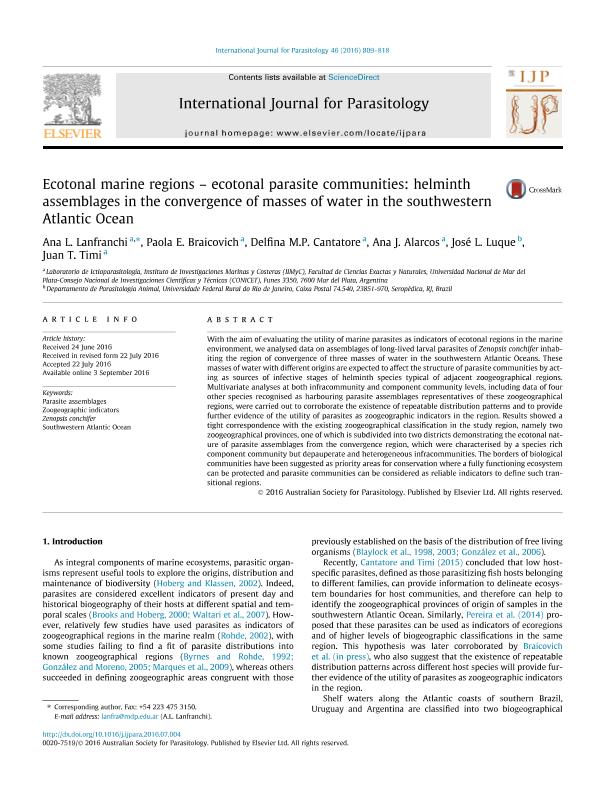Mostrar el registro sencillo del ítem
dc.contributor.author
Lanfranchi, Ana Laura

dc.contributor.author
Braicovich, Paola Elizabeth

dc.contributor.author
Cantatore, Delfina María Paula

dc.contributor.author
Alarcos, Ana Julia

dc.contributor.author
Luque, José L.
dc.contributor.author
Timi, Juan Tomas

dc.date.available
2018-08-15T19:31:07Z
dc.date.issued
2016-11
dc.identifier.citation
Lanfranchi, Ana Laura; Braicovich, Paola Elizabeth; Cantatore, Delfina María Paula; Alarcos, Ana Julia; Luque, José L.; et al.; Ecotonal marine regions – ecotonal parasite communities: helminth assemblages in the convergence of masses of water in the southwestern Atlantic Ocean; Elsevier; International Journal for Parasitology; 46; 12; 11-2016; 809-818
dc.identifier.issn
0020-7519
dc.identifier.uri
http://hdl.handle.net/11336/55721
dc.description.abstract
With the aim of evaluating the utility of marine parasites as indicators of ecotonal regions in the marine environment, we analysed data on assemblages of long-lived larval parasites of Zenopsis conchifer inhabiting the region of convergence of three masses of water in the southwestern Atlantic Oceans. These masses of water with different origins are expected to affect the structure of parasite communities by acting as sources of infective stages of helminth species typical of adjacent zoogeographical regions. Multivariate analyses at both infracommunity and component community levels, including data of four other species recognised as harbouring parasite assemblages representatives of these zoogeographical regions, were carried out to corroborate the existence of repeatable distribution patterns and to provide further evidence of the utility of parasites as zoogeographic indicators in the region. Results showed a tight correspondence with the existing zoogeographical classification in the study region, namely two zoogeographical provinces, one of which is subdivided into two districts demonstrating the ecotonal nature of parasite assemblages from the convergence region, which were characterised by a species rich component community but depauperate and heterogeneous infracommunities. The borders of biological communities have been suggested as priority areas for conservation where a fully functioning ecosystem can be protected and parasite communities can be considered as reliable indicators to define such transitional regions.
dc.format
application/pdf
dc.language.iso
eng
dc.publisher
Elsevier

dc.rights
info:eu-repo/semantics/openAccess
dc.rights.uri
https://creativecommons.org/licenses/by-nc-sa/2.5/ar/
dc.subject
Parasite Assemblages
dc.subject
Southwestern Atlantic Ocean
dc.subject
Zenopsis Conchifer
dc.subject
Zoogeographic Indicators
dc.subject.classification
Otras Ciencias Biológicas

dc.subject.classification
Ciencias Biológicas

dc.subject.classification
CIENCIAS NATURALES Y EXACTAS

dc.title
Ecotonal marine regions – ecotonal parasite communities: helminth assemblages in the convergence of masses of water in the southwestern Atlantic Ocean
dc.type
info:eu-repo/semantics/article
dc.type
info:ar-repo/semantics/artículo
dc.type
info:eu-repo/semantics/publishedVersion
dc.date.updated
2018-08-15T14:23:32Z
dc.journal.volume
46
dc.journal.number
12
dc.journal.pagination
809-818
dc.journal.pais
Países Bajos

dc.journal.ciudad
Amsterdam
dc.description.fil
Fil: Lanfranchi, Ana Laura. Consejo Nacional de Investigaciones Científicas y Técnicas. Centro Científico Tecnológico Conicet - Mar del Plata. Instituto de Investigaciones Marinas y Costeras. Universidad Nacional de Mar del Plata. Facultad de Ciencia Exactas y Naturales. Instituto de Investigaciones Marinas y Costeras; Argentina
dc.description.fil
Fil: Braicovich, Paola Elizabeth. Consejo Nacional de Investigaciones Científicas y Técnicas. Centro Científico Tecnológico Conicet - Mar del Plata. Instituto de Investigaciones Marinas y Costeras. Universidad Nacional de Mar del Plata. Facultad de Ciencia Exactas y Naturales. Instituto de Investigaciones Marinas y Costeras; Argentina
dc.description.fil
Fil: Cantatore, Delfina María Paula. Consejo Nacional de Investigaciones Científicas y Técnicas. Centro Científico Tecnológico Conicet - Mar del Plata. Instituto de Investigaciones Marinas y Costeras. Universidad Nacional de Mar del Plata. Facultad de Ciencia Exactas y Naturales. Instituto de Investigaciones Marinas y Costeras; Argentina
dc.description.fil
Fil: Alarcos, Ana Julia. Consejo Nacional de Investigaciones Científicas y Técnicas. Centro Científico Tecnológico Conicet - Mar del Plata. Instituto de Investigaciones Marinas y Costeras. Universidad Nacional de Mar del Plata. Facultad de Ciencia Exactas y Naturales. Instituto de Investigaciones Marinas y Costeras; Argentina
dc.description.fil
Fil: Luque, José L.. Universidade Federal Rural do Rio de Janeiro; Brasil
dc.description.fil
Fil: Timi, Juan Tomas. Consejo Nacional de Investigaciones Científicas y Técnicas. Centro Científico Tecnológico Conicet - Mar del Plata. Instituto de Investigaciones Marinas y Costeras. Universidad Nacional de Mar del Plata. Facultad de Ciencia Exactas y Naturales. Instituto de Investigaciones Marinas y Costeras; Argentina
dc.journal.title
International Journal for Parasitology

dc.relation.alternativeid
info:eu-repo/semantics/altIdentifier/doi/https://dx.doi.org/10.1016/j.ijpara.2016.07.004
dc.relation.alternativeid
info:eu-repo/semantics/altIdentifier/url/https://www.sciencedirect.com/science/article/pii/S0020751916301813
Archivos asociados
